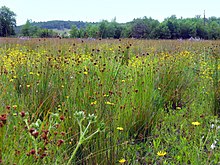
A grassland is an area where the vegetation is dominated by grasses (Poaceae). However, sedge (Cyperaceae) and rush (Juncaceae) can also be found along with variable proportions of legumes, like clover, and other herbs. Grasslands occur naturally on all continents except Antarctica and are found in most ecoregions of the Earth. Furthermore, grasslands are one of the largest biomes on Earth and dominate the landscape worldwide. There are different types of grasslands: natural grasslands, semi-natural grasslands, and agricultural grasslands. They cover 31–69% of the Earth's land area.
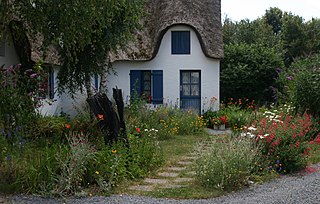
A wildlife garden is an environment created with the purpose to serve as a sustainable haven for surrounding wildlife. Wildlife gardens contain a variety of habitats that cater to native and local plants, birds, amphibians, reptiles, insects, mammals and so on, and are meant to sustain locally native flora and fauna. Other names this type of gardening goes by can vary, prominent ones being habitat, ecology, and conservation gardening.

Urban ecology is the scientific study of the relation of living organisms with each other and their surroundings in an urban environment. An urban environment refers to environments dominated by high-density residential and commercial buildings, paved surfaces, and other urban-related factors that create a unique landscape. The goal of urban ecology is to achieve a balance between human culture and the natural environment.

Urban forestry is the care and management of single trees and tree populations in urban settings for the purpose of improving the urban environment. Urban forestry involves both planning and management, including the programming of care and maintenance operations of the urban forest. Urban forestry advocates the role of trees as a critical part of the urban infrastructure. Urban foresters plant and maintain trees, support appropriate tree and forest preservation, conduct research and promote the many benefits trees provide. Urban forestry is practiced by municipal and commercial arborists, municipal and utility foresters, environmental policymakers, city planners, consultants, educators, researchers and community activists.

A pocket park is a small park accessible to the general public. While the locations, elements, and uses of pocket parks vary considerably, the common defining characteristic of a pocket park is its small size. Typically, a pocket park occupies one to three municipal lots and is smaller than 0.5 hectares in size.
An eco-city or ecocity is "a human settlement modeled on the self-sustaining resilient structure and function of natural ecosystems", as defined by Ecocity Builders. Simply put, an eco-city is an ecologically healthy city. The World Bank defines eco-cities as "cities that enhance the well-being of citizens and society through integrated urban planning and management that harness the benefits of ecological systems and protect and nurture these assets for future generations". Although there is no universally accepted definition of an 'eco-city', among available definitions, there is some consensus on the basic features of an eco-city.
Landscape planning is a branch of landscape architecture. According to Erv Zube (1931–2002) landscape planning is defined as an activity concerned with developing landscaping amongst competing land uses while protecting natural processes and significant cultural and natural resources. Park systems and greenways of the type designed by Frederick Law Olmsted are key examples of landscape planning. Landscape designers tend to work for clients who wish to commission construction work. Landscape planners analyze broad issues as well as project characteristics which constrain design projects.

The musk lorikeet is a lorikeet, now the only species in the genus Glossopsitta. It inhabits south-central/eastern Australia. The little lorikeet and the purple-crowned lorikeet were previously included in the genus. The musk lorikeet was first described by ornithologist George Shaw in 1790 as Psittacus concinnus, from a collection in the vicinity of Port Jackson in what is now Sydney. John Latham described it as Psittacus australis. Its specific epithet is the Latin concinna "elegant". Other common names include red-eared lorikeet, and green keet, and formerly a local Sydney indigenous term coolich. The names green leek and king parrot have been incorrectly applied to this species in the past.

A park system, also known as an open space system, is a network of green spaces that are connected by public walkways, bridleways or cycleways. The concept first emerged with the need to minimize fragmentation of natural environments and was referred to as "patch and corridor." In modern landscape architecture, the park system is collaborating with the idea of planning greenways, which run through urban and rural areas. These systems can serve the landscape through ecological, recreational, social, cultural, and healthful measures, and are designed with intentions of sustainability.

Green infrastructure or blue-green infrastructure refers to a network that provides the “ingredients” for solving urban and climatic challenges by building with nature. The main components of this approach include stormwater management, climate adaptation, the reduction of heat stress, increasing biodiversity, food production, better air quality, sustainable energy production, clean water, and healthy soils, as well as more anthropocentric functions, such as increased quality of life through recreation and the provision of shade and shelter in and around towns and cities. Green infrastructure also serves to provide an ecological framework for social, economic, and environmental health of the surroundings. More recently scholars and activists have also called for green infrastructure that promotes social inclusion and equity rather than reinforcing pre-existing structures of unequal access to nature-based services.
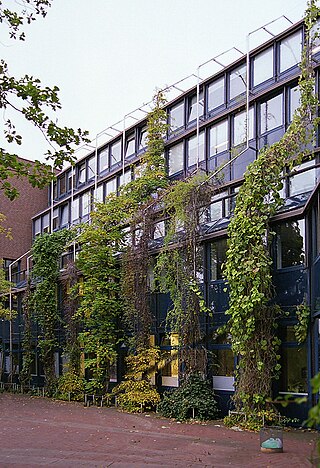
Greening is the process of transforming living environments, and also artifacts such as a space, a lifestyle or a brand image, into a more environmentally friendly version. The act of greening generally involves incorporating more environmentally friendly systems into one's environment, such as the home, work place, and general lifestyle.

Honglingjin Park is a public park in Beijing.
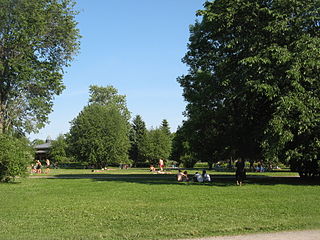
In land-use planning, urban green space is open-space areas reserved for parks and other "green spaces", including plant life, water features - also referred to as blue spaces - and other kinds of natural environment. Most urban open spaces are green spaces, but occasionally include other kinds of open areas. The landscape of urban open spaces can range from playing fields to highly maintained environments to relatively natural landscapes.
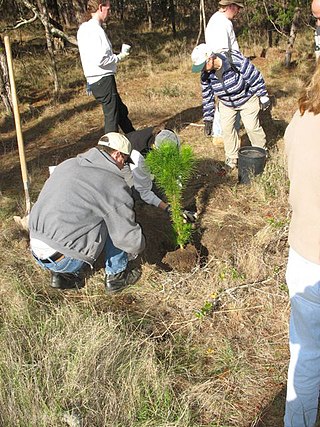
Urban reforestation is the practice of planting trees, typically on a large scale, in urban environments. It may also include urban horticulture and urban farming.

Brachyolus bagooides is a broad-nosed weevil that is endemic to New Zealand. This species can be found in private gardens in Dunedin and the Rock and Pillar Range of Otago.

Sarah Bekessy is an Australian interdisciplinary conservation scientist with a background in conservation biology and experience in social sciences, planning, and design. Her research interests focus on the intersection between science, policy, and the design of environmental management. She is currently a professor and ARC Future Fellow at RMIT University in the School of Global, Urban and Social Studies. She leads the Interdisciplinary Conservation Science Research Group.

Norah Geddes (1887–1967) was a Scottish landscape designer.
Soil sealing or soil surface sealing is the loss of soil resources due to the covering of land for housing, roads or other construction work. Covering or replacing the topsoil with impervious materials like asphalt and cement as a result of urban development and infrastructure construction paired with compaction of the underlying soil layers results in the mostly irreversible loss of relevant soil ecosystem services.The global rise in population has heightened the need for soil sealing, which in turn leads to the degradation of land. Sealed land is a serious form of land take .Soil sealing and land take together leads to the complete loss of soil functions, including its biological, physical and chemical properties.
The Rural-Urban gradient is a gradient that is used to describe how Anthropocene effects affect their surroundings and how they compare to areas less affected by Anthropocene effects. Effects such as but, not limited to disturbance, change in biota, pollution, and landscape modification. Mainly used in the context of ecosystem services, it has also been used to describe biodiversity along the gradient, as well as behavioral change.

An urban meadow is a meadow which is influenced both by the environmental conditions of a city and the aesthetic and social needs of its residents. This differs from other meadow types as it is a highly engineered, novel, and site-specific designed landscape as well as an example of a nature-based solution (NBS).

